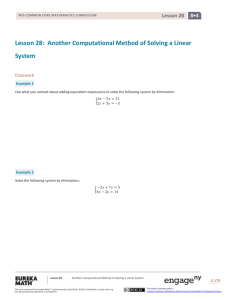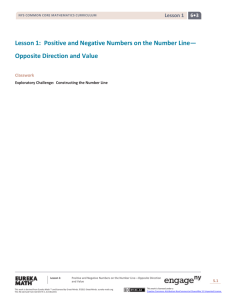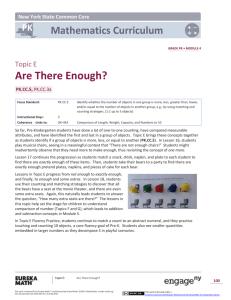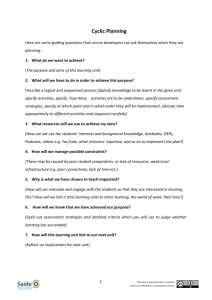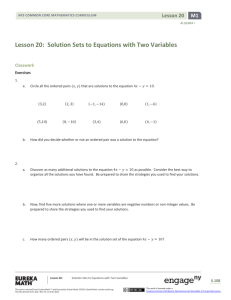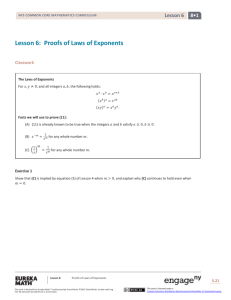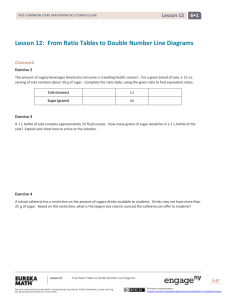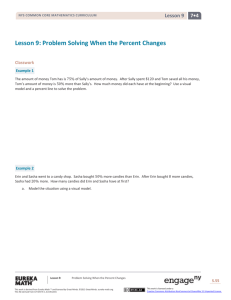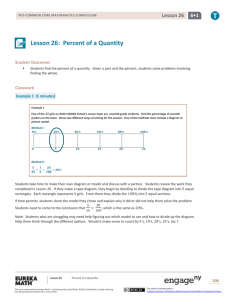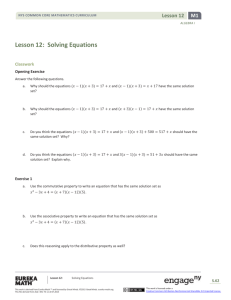Lesson 28 - EngageNY
advertisement
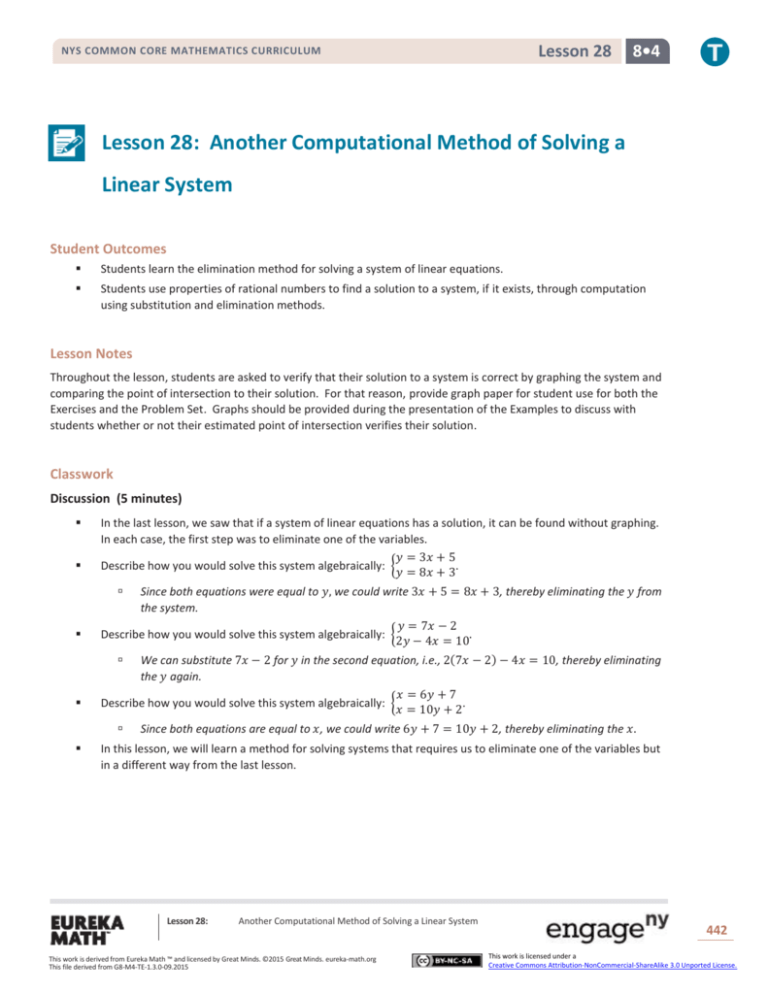
Lesson 28
NYS COMMON CORE MATHEMATICS CURRICULUM
8•4
Lesson 28: Another Computational Method of Solving a
Linear System
Student Outcomes
Students learn the elimination method for solving a system of linear equations.
Students use properties of rational numbers to find a solution to a system, if it exists, through computation
using substitution and elimination methods.
Lesson Notes
Throughout the lesson, students are asked to verify that their solution to a system is correct by graphing the system and
comparing the point of intersection to their solution. For that reason, provide graph paper for student use for both the
Exercises and the Problem Set. Graphs should be provided during the presentation of the Examples to discuss with
students whether or not their estimated point of intersection verifies their solution.
Classwork
Discussion (5 minutes)
In the last lesson, we saw that if a system of linear equations has a solution, it can be found without graphing.
In each case, the first step was to eliminate one of the variables.
𝑦 = 3𝑥 + 5
Describe how you would solve this system algebraically: {
.
𝑦 = 8𝑥 + 3
Since both equations were equal to 𝑦, we could write 3𝑥 + 5 = 8𝑥 + 3, thereby eliminating the 𝑦 from
the system.
𝑦 = 7𝑥 − 2
Describe how you would solve this system algebraically: {
.
2𝑦 − 4𝑥 = 10
We can substitute 7𝑥 − 2 for 𝑦 in the second equation, i.e., 2(7𝑥 − 2) − 4𝑥 = 10, thereby eliminating
the 𝑦 again.
𝑥 = 6𝑦 + 7
Describe how you would solve this system algebraically: {
.
𝑥 = 10𝑦 + 2
Since both equations are equal to 𝑥, we could write 6𝑦 + 7 = 10𝑦 + 2, thereby eliminating the 𝑥.
In this lesson, we will learn a method for solving systems that requires us to eliminate one of the variables but
in a different way from the last lesson.
Lesson 28:
Another Computational Method of Solving a Linear System
This work is derived from Eureka Math ™ and licensed by Great Minds. ©2015 Great Minds. eureka-math.org
This file derived from G8-M4-TE-1.3.0-09.2015
442
This work is licensed under a
Creative Commons Attribution-NonCommercial-ShareAlike 3.0 Unported License.
Lesson 28
NYS COMMON CORE MATHEMATICS CURRICULUM
8•4
Example 1 (8 minutes)
Example 1
Use what you noticed about adding equivalent expressions to solve the following system by elimination:
{
𝟔𝒙 − 𝟓𝒚 = 𝟐𝟏
𝟐𝒙 + 𝟓𝒚 = −𝟓
Show students the three examples of adding integer equations together. Ask students to verbalize what they notice in
the examples and to generalize what they observe. The goal is for students to see that they can add equivalent
expressions and still have an equivalence.
Example 1: If 2 + 5 = 7 and 1 + 9 = 10, does 2 + 5 + 1 + 9 = 7 + 10?
Example 2: If 1 + 5 = 6 and 7 − 2 = 5, does 1 + 5 + 7 − 2 = 6 + 5?
Example 3: If −3 + 11 = 8 and 2 + 1 = 3, does −3 + 11 + 2 + 1 = 8 + 3?
MP.1
Use what you noticed about adding equivalent expressions to solve the following system by elimination:
6𝑥 − 5𝑦 = 21
{
2𝑥 + 5𝑦 = −5
Provide students with time to attempt to solve the system by adding the equations together. Have students share their
work with the class. If necessary, use the points belows to support students.
Notice that terms −5𝑦 and 5𝑦 are opposites; that is, they have a sum of zero when added. If we were to add
the equations in the system, the 𝑦 would be eliminated.
6𝑥 − 5𝑦 + 2𝑥 + 5𝑦 = 21 + (−5)
6𝑥 + 2𝑥 − 5𝑦 + 5𝑦 = 16
8𝑥 = 16
𝑥=2
Just as before, now that we know what 𝑥 is, we can substitute it into either equation to determine the value of
𝑦.
2(2) + 5𝑦 = −5
4 + 5𝑦 = −5
5𝑦 = −9
9
𝑦=−
5
9
5
The solution to the system is (2, − ).
Lesson 28:
Another Computational Method of Solving a Linear System
This work is derived from Eureka Math ™ and licensed by Great Minds. ©2015 Great Minds. eureka-math.org
This file derived from G8-M4-TE-1.3.0-09.2015
443
This work is licensed under a
Creative Commons Attribution-NonCommercial-ShareAlike 3.0 Unported License.
Lesson 28
NYS COMMON CORE MATHEMATICS CURRICULUM
8•4
We can verify our solution by sketching the graphs of the system.
Example 2 (5 minutes)
Example 2
Solve the following system by elimination:
{
−𝟐𝒙 + 𝟕𝒚 = 𝟓
𝟒𝒙 − 𝟐𝒚 = 𝟏𝟒
We will solve the following system by elimination:
−2𝑥 + 7𝑦 = 5
{
4𝑥 − 2𝑦 = 14
In this example, it is not as obvious which variable to eliminate. It will become obvious as soon as we multiply
the first equation by 2.
2(−2𝑥 + 7𝑦 = 5)
−4𝑥 + 14𝑦 = 10
−4𝑥 + 14𝑦 = 10
Now we have the system {
. It is clear that when we add −4𝑥 + 4𝑥, the 𝑥 will be eliminated.
4𝑥 − 2𝑦 = 14
Add the equations of this system together, and determine the solution to the system.
Lesson 28:
Another Computational Method of Solving a Linear System
This work is derived from Eureka Math ™ and licensed by Great Minds. ©2015 Great Minds. eureka-math.org
This file derived from G8-M4-TE-1.3.0-09.2015
444
This work is licensed under a
Creative Commons Attribution-NonCommercial-ShareAlike 3.0 Unported License.
Lesson 28
NYS COMMON CORE MATHEMATICS CURRICULUM
8•4
Sample student work:
−4𝑥 + 14𝑦 + 4𝑥 − 2𝑦 = 10 + 14
4𝑥 − 2(2) = 14
14𝑦 − 2𝑦 = 24
4𝑥 − 4 = 14
12𝑦 = 24
4𝑥 = 18
18
𝑥=
4
9
𝑥=
2
𝑦=2
9
2
The solution to the system is ( , 2).
We can verify our solution by sketching the graphs of the system.
Example 3 (5 minutes)
Example 3
Solve the following system by elimination:
{
𝟕𝒙 − 𝟓𝒚 = −𝟐
𝟑𝒙 − 𝟑𝒚 = 𝟕
We will solve the following system by elimination:
7𝑥 − 5𝑦 = −2
{
3𝑥 − 3𝑦 = 7
MP.1
Provide time for students to solve this system on their own before discussing it as a class.
Lesson 28:
Another Computational Method of Solving a Linear System
This work is derived from Eureka Math ™ and licensed by Great Minds. ©2015 Great Minds. eureka-math.org
This file derived from G8-M4-TE-1.3.0-09.2015
445
This work is licensed under a
Creative Commons Attribution-NonCommercial-ShareAlike 3.0 Unported License.
Lesson 28
NYS COMMON CORE MATHEMATICS CURRICULUM
8•4
In this case, it is even less obvious which variable to eliminate. On these occasions, we need to rewrite both
equations. We multiply the first equation by −3 and the second equation by 7.
−3(7𝑥 − 5𝑦 = −2)
−21𝑥 + 15𝑦 = 6
7(3𝑥 − 3𝑦 = 7)
21𝑥 − 21𝑦 = 49
MP.1
−21𝑥 + 15𝑦 = 6
Now we have the system {
, and it is obvious that the 𝑥 can be eliminated.
21𝑥 − 21𝑦 = 49
Look at the system again.
7𝑥 − 5𝑦 = −2
{
3𝑥 − 3𝑦 = 7
What would we do if we wanted to eliminate the 𝑦 from the system?
We could multiply the first equation by 3 and the second equation by −5.
Students may say to multiply the first equation by −3 and the second equation by 5. Whichever answer is given first,
ask if the second is also a possibility. Students should answer yes. Then have students solve the system.
Sample student work:
−21𝑥 + 15𝑦 = 6
{
21𝑥 − 21𝑦 = 49
15𝑦 − 21𝑦 = 6 + 49
−6𝑦 = 55
55
𝑦=−
6
55
7𝑥 − 5 (− ) = −2
6
275
7𝑥 +
= −2
6
287
7𝑥 = −
6
287
𝑥=−
42
The solution to the system is (−
Lesson 28:
287
55
, − ).
42
6
Another Computational Method of Solving a Linear System
This work is derived from Eureka Math ™ and licensed by Great Minds. ©2015 Great Minds. eureka-math.org
This file derived from G8-M4-TE-1.3.0-09.2015
446
This work is licensed under a
Creative Commons Attribution-NonCommercial-ShareAlike 3.0 Unported License.
NYS COMMON CORE MATHEMATICS CURRICULUM
Lesson 28
8•4
Exercises (8 minutes)
Students complete Exercises 1–3 independently.
Exercises
Each of the following systems has a solution. Determine the solution to the system by eliminating one of the variables.
Verify the solution using the graph of the system.
1.
{
𝟔𝒙 − 𝟕𝒚 = −𝟏𝟎
𝟑𝒙 + 𝟕𝒚 = −𝟖
𝟔𝒙 − 𝟕𝒚 + 𝟑𝒙 + 𝟕𝒚 = −𝟏𝟎 + (−𝟖)
𝟗𝒙 = −𝟏𝟖
𝒙 = −𝟐
𝟑(−𝟐) + 𝟕𝒚 = −𝟖
−𝟔 + 𝟕𝒚 = −𝟖
𝟕𝒚 = −𝟐
𝟐
𝒚=−
𝟕
𝟐
𝟕
The solution is (−𝟐, − ).
2.
{
𝒙 − 𝟒𝒚 = 𝟕
𝟓𝒙 + 𝟗𝒚 = 𝟔
−𝟓(𝒙 − 𝟒𝒚 = 𝟕)
−𝟓𝒙 + 𝟐𝟎𝒚 = −𝟑𝟓
−𝟓𝒙 + 𝟐𝟎𝒚 = −𝟑𝟓
{
𝟓𝒙 + 𝟗𝒚 = 𝟔
−𝟓𝒙 + 𝟐𝟎𝒚 + 𝟓𝒙 + 𝟗𝒚 = −𝟑𝟓 + 𝟔
𝟐𝟗𝒚 = −𝟐𝟗
𝒚 = −𝟏
𝒙 − 𝟒(−𝟏) = 𝟕
𝒙+𝟒 =𝟕
𝒙=𝟑
The solution is (𝟑, −𝟏).
Lesson 28:
Another Computational Method of Solving a Linear System
This work is derived from Eureka Math ™ and licensed by Great Minds. ©2015 Great Minds. eureka-math.org
This file derived from G8-M4-TE-1.3.0-09.2015
447
This work is licensed under a
Creative Commons Attribution-NonCommercial-ShareAlike 3.0 Unported License.
Lesson 28
NYS COMMON CORE MATHEMATICS CURRICULUM
{
3.
8•4
𝟐𝒙 − 𝟑𝒚 = −𝟓
𝟑𝒙 + 𝟓𝒚 = 𝟏
−𝟑(𝟐𝒙 − 𝟑𝒚 = −𝟓)
−𝟔𝒙 + 𝟗𝒚 = 𝟏𝟓
𝟐(𝟑𝒙 + 𝟓𝒚 = 𝟏)
𝟔𝒙 + 𝟏𝟎𝒚 = 𝟐
{
−𝟔𝒙 + 𝟗𝒚 = 𝟏𝟓
𝟔𝒙 + 𝟏𝟎𝒚 = 𝟐
−𝟔𝒙 + 𝟗𝒚 + 𝟔𝒙 + 𝟏𝟎𝒚 = 𝟏𝟓 + 𝟐
𝟏𝟗𝒚 = 𝟏𝟕
𝟏𝟕
𝒚=
𝟏𝟗
𝟏𝟕
𝟐𝒙 − 𝟑 ( ) = −𝟓
𝟏𝟗
𝟓𝟏
𝟐𝒙 −
= −𝟓
𝟏𝟗
𝟐𝒙 = −𝟓 +
𝟓𝟏
𝟏𝟗
𝟒𝟒
𝟏𝟗
𝟒𝟒
𝒙=−
𝟑𝟖
𝟐𝟐
𝒙=−
𝟏𝟗
𝟐𝒙 = −
The solution is (−
𝟐𝟐 𝟏𝟕
, ).
𝟏𝟗 𝟏𝟗
Discussion (6 minutes)
Systems of linear equations can be solved by sketching the graphs of the lines defined by the equations of the
system and looking for the intersection of the lines, substitution (as was shown in the last lesson), or
elimination (as was shown in this lesson). Some systems can be solved more efficiently by elimination, while
others by substitution. Which method do you think would be most efficient for the following system? Explain.
{
𝑦 = 5𝑥 − 19
3𝑥 + 11 = 𝑦
Substitution would be the most efficient method. Since each equation is equal to 𝑦, it would be easiest
to write the expressions 5𝑥 − 19 and 3𝑥 + 11 equal to one another; then, solve for 𝑦.
What method would you use for the following system? Explain.
{
2𝑥 − 9𝑦 = 7
𝑥 + 9𝑦 = 5
Elimination would be the most efficient method because the terms −9𝑦 + 9𝑦, when added, would
eliminate the 𝑦 from the equation.
Lesson 28:
Another Computational Method of Solving a Linear System
This work is derived from Eureka Math ™ and licensed by Great Minds. ©2015 Great Minds. eureka-math.org
This file derived from G8-M4-TE-1.3.0-09.2015
448
This work is licensed under a
Creative Commons Attribution-NonCommercial-ShareAlike 3.0 Unported License.
Lesson 28
NYS COMMON CORE MATHEMATICS CURRICULUM
8•4
What method would you use for the following system? Explain.
4𝑥 − 3𝑦 = −8
{
𝑥 + 7𝑦 = 4
Elimination would likely be the most efficient method because we could multiply the second equation
by −4 to eliminate the 𝑥 from the equation.
What method would you use for the following system? Explain.
{
𝑥 + 𝑦 = −3
6𝑥 + 6𝑦 = 6
Accept any reasonable answer students provide; then, remind them that the most efficient use of time
is to check to see if the system has a solution at all. Since the slopes of the graphs of these lines are
parallel, this system has no solution.
Closing (4 minutes)
Summarize, or ask students to summarize, the main points from the lesson:
We know how to solve a system by eliminating one of the variables. In some cases, we will have to multiply
one or both of the given equations by a constant in order to eliminate a variable.
We know that some systems are solved more efficiently by elimination than by other methods.
Lesson Summary
Systems of linear equations can be solved by eliminating one of the variables from the system. One way to
eliminate a variable is by setting both equations equal to the same variable and then writing the expressions equal
to one another.
Example: Solve the system {
𝒚 = 𝟑𝒙 − 𝟒
.
𝒚 = 𝟐𝒙 + 𝟏
Since the expressions 𝟑𝒙 − 𝟒 and 𝟐𝒙 + 𝟏 are both equal to 𝒚, they can be set equal to each other and the new
equation can be solved for 𝒙:
𝟑𝒙 − 𝟒 = 𝟐𝒙 + 𝟏
Another way to eliminate a variable is by multiplying each term of an equation by the same constant to make an
equivalent equation. Then, use the equivalent equation to eliminate one of the variables and solve the system.
Example: Solve the system {
𝟐𝒙 + 𝒚 = 𝟖
.
𝒙 + 𝒚 = 𝟏𝟎
Multiply the second equation by −𝟐 to eliminate the 𝒙.
−𝟐(𝒙 + 𝒚 = 𝟏𝟎)
−𝟐𝒙 − 𝟐𝒚 = −𝟐𝟎
Now we have the system {
𝟐𝒙 + 𝒚 = 𝟖
.
−𝟐𝒙 − 𝟐𝒚 = −𝟐𝟎
When the equations are added together, the 𝒙 is eliminated.
𝟐𝒙 + 𝒚 − 𝟐𝒙 − 𝟐𝒚 = 𝟖 + (−𝟐𝟎)
𝒚 − 𝟐𝒚 = 𝟖 + (−𝟐𝟎)
Once a solution has been found, verify the solution graphically or by substitution.
Lesson 28:
Another Computational Method of Solving a Linear System
This work is derived from Eureka Math ™ and licensed by Great Minds. ©2015 Great Minds. eureka-math.org
This file derived from G8-M4-TE-1.3.0-09.2015
449
This work is licensed under a
Creative Commons Attribution-NonCommercial-ShareAlike 3.0 Unported License.
NYS COMMON CORE MATHEMATICS CURRICULUM
Lesson 28
8•4
Exit Ticket (4 minutes)
The graphs have been provided in the Exit Ticket in order to allow students to check their solutions within the four
minutes allotted.
Lesson 28:
Another Computational Method of Solving a Linear System
This work is derived from Eureka Math ™ and licensed by Great Minds. ©2015 Great Minds. eureka-math.org
This file derived from G8-M4-TE-1.3.0-09.2015
450
This work is licensed under a
Creative Commons Attribution-NonCommercial-ShareAlike 3.0 Unported License.
Lesson 28
NYS COMMON CORE MATHEMATICS CURRICULUM
Name
8•4
Date
Lesson 28: Another Computational Method of Solving a Linear
System
Exit Ticket
Determine the solution, if it exists, for each system of linear equations. Verify your solution on the coordinate plane.
1.
𝑦 = 3𝑥 − 5
{
𝑦 = −3𝑥 + 7
2.
𝑦 = −4𝑥 + 6
{
2𝑥 − 𝑦 = 11
Lesson 28:
Another Computational Method of Solving a Linear System
This work is derived from Eureka Math ™ and licensed by Great Minds. ©2015 Great Minds. eureka-math.org
This file derived from G8-M4-TE-1.3.0-09.2015
451
This work is licensed under a
Creative Commons Attribution-NonCommercial-ShareAlike 3.0 Unported License.
NYS COMMON CORE MATHEMATICS CURRICULUM
Lesson 28
8•4
Exit Ticket Sample Solutions
Determine the solution, if it exists, for each system of linear equations. Verify your solution on the coordinate plane.
1.
{
𝒚 = 𝟑𝒙 − 𝟓
𝒚 = −𝟑𝒙 + 𝟕
𝟑𝒙 − 𝟓 = −𝟑𝒙 + 𝟕
𝟔𝒙 = 𝟏𝟐
𝒙=𝟐
𝒚 = 𝟑(𝟐) − 𝟓
𝒚 =𝟔−𝟓
𝒚=𝟏
The solution is (𝟐, 𝟏).
2.
{
𝒚 = −𝟒𝒙 + 𝟔
𝟐𝒙 − 𝒚 = 𝟏𝟏
𝟐𝒙 − (−𝟒𝒙 + 𝟔) = 𝟏𝟏
𝟐𝒙 + 𝟒𝒙 − 𝟔 = 𝟏𝟏
𝟔𝒙 = 𝟏𝟕
𝟏𝟕
𝒙=
𝟔
𝟏𝟕
𝒚 = −𝟒 ( ) + 𝟔
𝟔
𝟑𝟒
𝒚=−
+𝟔
𝟑
𝟏𝟔
𝒚=−
𝟑
The solution is (
𝟏𝟕
𝟏𝟔
, − ).
𝟔
𝟑
Lesson 28:
Another Computational Method of Solving a Linear System
This work is derived from Eureka Math ™ and licensed by Great Minds. ©2015 Great Minds. eureka-math.org
This file derived from G8-M4-TE-1.3.0-09.2015
452
This work is licensed under a
Creative Commons Attribution-NonCommercial-ShareAlike 3.0 Unported License.
NYS COMMON CORE MATHEMATICS CURRICULUM
Lesson 28
8•4
Problem Set Sample Solutions
Determine the solution, if it exists, for each system of linear equations. Verify your solution on the coordinate plane.
𝟏
1.
𝒙+𝟓=𝒚
{𝟐
𝟐𝒙 + 𝒚 = 𝟏
𝟏
𝟐𝒙 + 𝒙 + 𝟓 = 𝟏
𝟐
𝟓
𝒙+𝟓= 𝟏
𝟐
𝟓
𝒙 = −𝟒
𝟐
𝟖
𝒙=−
𝟓
𝟖
𝟐 (− ) + 𝒚 = 𝟏
𝟓
𝟏𝟔
−
+𝒚=𝟏
𝟓
𝟐𝟏
𝒚=
𝟓
𝟖 𝟐𝟏
).
𝟓 𝟓
The solution is (− ,
2.
{
𝟗𝒙 + 𝟐𝒚 = 𝟗
−𝟑𝒙 + 𝒚 = 𝟐
𝟑(−𝟑𝒙 + 𝒚 = 𝟐)
−𝟗𝒙 + 𝟑𝒚 = 𝟔
𝟗𝒙 + 𝟐𝒚 = 𝟗
{
−𝟗𝒙 + 𝟑𝒚 = 𝟔
𝟗𝒙 + 𝟐𝒚 − 𝟗𝒙 + 𝟑𝒚 = 𝟏𝟓
𝟓𝒚 = 𝟏𝟓
𝒚=𝟑
−𝟑𝒙 + 𝟑 = 𝟐
−𝟑𝒙 = −𝟏
𝟏
𝒙=
𝟑
𝟏
𝟑
The solution is ( , 𝟑).
Lesson 28:
Another Computational Method of Solving a Linear System
This work is derived from Eureka Math ™ and licensed by Great Minds. ©2015 Great Minds. eureka-math.org
This file derived from G8-M4-TE-1.3.0-09.2015
453
This work is licensed under a
Creative Commons Attribution-NonCommercial-ShareAlike 3.0 Unported License.
NYS COMMON CORE MATHEMATICS CURRICULUM
3.
{
Lesson 28
8•4
𝒚 = 𝟐𝒙 − 𝟐
𝟐𝒚 = 𝟒𝒙 − 𝟒
These equations define the same line. Therefore,
this system will have infinitely many solutions.
4.
{
𝟖𝒙 + 𝟓𝒚 = 𝟏𝟗
−𝟖𝒙 + 𝒚 = −𝟏
𝟖𝒙 + 𝟓𝒚 − 𝟖𝒙 + 𝒚 = 𝟏𝟗 − 𝟏
𝟓𝒚 + 𝒚 = 𝟏𝟖
𝟔𝒚 = 𝟏𝟖
𝒚=𝟑
𝟖𝒙 + 𝟓(𝟑) = 𝟏𝟗
𝟖𝒙 + 𝟏𝟓 = 𝟏𝟗
𝟖𝒙 = 𝟒
𝟏
𝒙=
𝟐
𝟏
𝟐
The solution is ( , 𝟑).
Lesson 28:
Another Computational Method of Solving a Linear System
This work is derived from Eureka Math ™ and licensed by Great Minds. ©2015 Great Minds. eureka-math.org
This file derived from G8-M4-TE-1.3.0-09.2015
454
This work is licensed under a
Creative Commons Attribution-NonCommercial-ShareAlike 3.0 Unported License.
NYS COMMON CORE MATHEMATICS CURRICULUM
5.
{
Lesson 28
8•4
𝒙+𝟑= 𝒚
𝟑𝒙 + 𝟒𝒚 = 𝟕
𝟑𝒙 + 𝟒(𝒙 + 𝟑) = 𝟕
𝟑𝒙 + 𝟒𝒙 + 𝟏𝟐 = 𝟕
𝟕𝒙 + 𝟏𝟐 = 𝟕
𝟕𝒙 = −𝟓
𝟓
𝒙=−
𝟕
𝟓
− +𝟑=𝒚
𝟕
𝟏𝟔
=𝒚
𝟕
𝟓 𝟏𝟔
).
𝟕 𝟕
The solution is (− ,
6.
{
𝒚 = 𝟑𝒙 + 𝟐
𝟒𝒚 = 𝟏𝟐 + 𝟏𝟐𝒙
The equations graph as distinct lines. The slopes of these two equations are the same, and the 𝒚-intercept points are
different, which means they graph as parallel lines. Therefore, this system will have no solution.
Lesson 28:
Another Computational Method of Solving a Linear System
This work is derived from Eureka Math ™ and licensed by Great Minds. ©2015 Great Minds. eureka-math.org
This file derived from G8-M4-TE-1.3.0-09.2015
455
This work is licensed under a
Creative Commons Attribution-NonCommercial-ShareAlike 3.0 Unported License.
NYS COMMON CORE MATHEMATICS CURRICULUM
7.
{
Lesson 28
8•4
𝟒𝒙 − 𝟑𝒚 = 𝟏𝟔
−𝟐𝒙 + 𝟒𝒚 = −𝟐
𝟐(−𝟐𝒙 + 𝟒𝒚 = −𝟐)
−𝟒𝒙 + 𝟖𝒚 = −𝟒
{
𝟒𝒙 − 𝟑𝒚 = 𝟏𝟔
−𝟒𝒙 + 𝟖𝒚 = −𝟒
𝟒𝒙 − 𝟑𝒚 − 𝟒𝒙 + 𝟖𝒚 = 𝟏𝟔 − 𝟒
−𝟑𝒚 + 𝟖𝒚 = 𝟏𝟐
𝟓𝒚 = 𝟏𝟐
𝟏𝟐
𝒚=
𝟓
𝟏𝟐
𝟒𝒙 − 𝟑 ( ) = 𝟏𝟔
𝟓
𝟑𝟔
𝟒𝒙 −
= 𝟏𝟔
𝟓
𝟏𝟏𝟔
𝟒𝒙 =
𝟓
𝟐𝟗
𝒙=
𝟓
𝟐𝟗 𝟏𝟐
The solution is (
8.
{
𝟓
,
𝟓
).
𝟐𝒙 + 𝟐𝒚 = 𝟒
𝟏𝟐 − 𝟑𝒙 = 𝟑𝒚
The equations graph as distinct lines. The slopes of these two equations are the same, and the 𝒚-intercept points are
different, which means they graph as parallel lines. Therefore, this system will have no solution.
Lesson 28:
Another Computational Method of Solving a Linear System
This work is derived from Eureka Math ™ and licensed by Great Minds. ©2015 Great Minds. eureka-math.org
This file derived from G8-M4-TE-1.3.0-09.2015
456
This work is licensed under a
Creative Commons Attribution-NonCommercial-ShareAlike 3.0 Unported License.
Lesson 28
NYS COMMON CORE MATHEMATICS CURRICULUM
9.
{
8•4
𝒚 = −𝟐𝒙 + 𝟔
𝟑𝒚 = 𝒙 − 𝟑
𝟑(𝒚 = −𝟐𝒙 + 𝟔)
𝟑𝒚 = −𝟔𝒙 + 𝟏𝟖
𝟑𝒚 = −𝟔𝒙 + 𝟏𝟖
{
𝟑𝒚 = 𝒙 − 𝟑
−𝟔𝒙 + 𝟏𝟖 = 𝒙 − 𝟑
𝟏𝟖 = 𝟕𝒙 − 𝟑
𝟐𝟏 = 𝟕𝒙
𝟐𝟏
=𝒙
𝟕
𝒙=𝟑
𝒚 = −𝟐(𝟑) + 𝟔
𝒚 = −𝟔 + 𝟔
𝒚=𝟎
The solution is (𝟑, 𝟎).
10. {
𝒚 = 𝟓𝒙 − 𝟏
𝟏𝟎𝒙 = 𝟐𝒚 + 𝟐
These equations define the same line. Therefore, this system will have infinitely many solutions.
Lesson 28:
Another Computational Method of Solving a Linear System
This work is derived from Eureka Math ™ and licensed by Great Minds. ©2015 Great Minds. eureka-math.org
This file derived from G8-M4-TE-1.3.0-09.2015
457
This work is licensed under a
Creative Commons Attribution-NonCommercial-ShareAlike 3.0 Unported License.
NYS COMMON CORE MATHEMATICS CURRICULUM
11. {
Lesson 28
8•4
𝟑𝒙 − 𝟓𝒚 = 𝟏𝟕
𝟔𝒙 + 𝟓𝒚 = 𝟏𝟎
𝟑𝒙 − 𝟓𝒚 + 𝟔𝒙 + 𝟓𝒚 = 𝟏𝟕 + 𝟏𝟎
𝟗𝒙 = 𝟐𝟕
𝒙=𝟑
𝟑(𝟑) − 𝟓𝒚 = 𝟏𝟕
𝟗 − 𝟓𝒚 = 𝟏𝟕
−𝟓𝒚 = 𝟖
𝒚=−
𝟖
𝟓
𝟖
𝟓
The solution is (𝟑, − ).
𝟒
𝒚 = 𝒙−𝟗
𝟑
12. {
𝒚 =𝒙+𝟑
𝟒
𝒙−𝟗= 𝒙+𝟑
𝟑
𝟏
𝒙−𝟗= 𝟑
𝟑
𝟏
𝒙 = 𝟏𝟐
𝟑
𝒙 = 𝟑𝟔
𝒚 = 𝟑𝟔 + 𝟑
𝒚 = 𝟑𝟗
The solution is (𝟑𝟔, 𝟑𝟗).
Lesson 28:
Another Computational Method of Solving a Linear System
This work is derived from Eureka Math ™ and licensed by Great Minds. ©2015 Great Minds. eureka-math.org
This file derived from G8-M4-TE-1.3.0-09.2015
458
This work is licensed under a
Creative Commons Attribution-NonCommercial-ShareAlike 3.0 Unported License.
NYS COMMON CORE MATHEMATICS CURRICULUM
13.
{
Lesson 28
8•4
𝟒𝒙 − 𝟕𝒚 = 𝟏𝟏
𝒙 + 𝟐𝒚 = 𝟏𝟎
−𝟒(𝒙 + 𝟐𝒚 = 𝟏𝟎)
−𝟒𝒙 − 𝟖𝒚 = −𝟒𝟎
{
𝟒𝒙 − 𝟕𝒚 = 𝟏𝟏
−𝟒𝒙 − 𝟖𝒚 = −𝟒𝟎
𝟒𝒙 − 𝟕𝒚 − 𝟒𝒙 − 𝟖𝒚 = 𝟏𝟏 − 𝟒𝟎
−𝟏𝟓𝒚 = −𝟐𝟗
𝟐𝟗
𝒚=
𝟏𝟓
𝟐𝟗
𝒙 + 𝟐 ( ) = 𝟏𝟎
𝟏𝟓
𝟓𝟖
𝒙+
= 𝟏𝟎
𝟏𝟓
𝟗𝟐
𝒙=
𝟏𝟓
The solution is (
14. {
𝟗𝟐 𝟐𝟗
, ).
𝟏𝟓 𝟏𝟓
𝟐𝟏𝒙 + 𝟏𝟒𝒚 = 𝟕
𝟏𝟐𝒙 + 𝟖𝒚 = 𝟏𝟔
The slopes of these two equations are the same, and the 𝒚-intercept points are different, which means they graph as
parallel lines. Therefore, this system will have no solution.
Lesson 28:
Another Computational Method of Solving a Linear System
This work is derived from Eureka Math ™ and licensed by Great Minds. ©2015 Great Minds. eureka-math.org
This file derived from G8-M4-TE-1.3.0-09.2015
459
This work is licensed under a
Creative Commons Attribution-NonCommercial-ShareAlike 3.0 Unported License.
